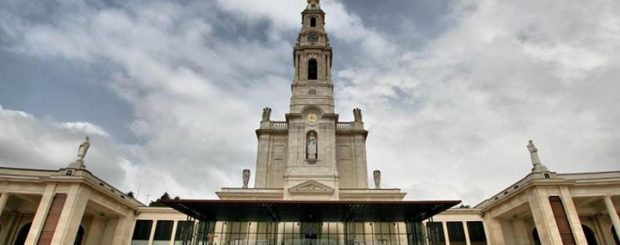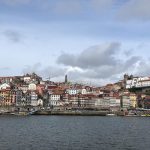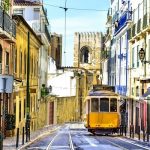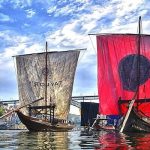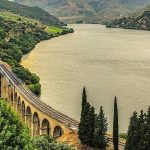Itinerary 9 days in Portugal, nine days of tours in Portugal, privately and tailor-made, an itinerary that begins and ends in the city of Lisbon, with overnight stays in Coimbra and Porto.
Not included
- Meals
- Entrance Fees
Included
- Accredited and exclusive guide
- Bottled waters
- Free wifi
Prices
| 2 People – 2960€ | 6 People – 3520€ |
| 3 People – 3150€ | 7 People – 3650€ |
| 4 People – 3250€ | 8 People – 3900€ |
| 5 People – 3400€ |
Itinerary 9 days in Portugal
Some curiosities about Portugal, which we hope will discover in our itinerary 9 days in Portugal …
The visit to the Templars Castle in Tomar is essential, as well as the Church of D. Manuel I and the Renaissance cloister that Diogo de Torralva superimposed on the cloister just concluded by the also extraordinary Joao de Castilho.
Here you can find in an exemplary of the so-called Portuguese “Estilo Chão”, an exclusively Portuguese architectural development, through the Convento de Cristo we can learn about the history of Portugal, its foundation, the importance of the Templars in Portugal.
Undoubtedly, the water of the Atlantic gets colder as we go north, however the beaches are still beautiful, from Foz do Douro, Minho, Viana do Castelo, where Monte de Santa Luzia impresses those who pass by.
Portugal is known for having a rich cultural heritage, thanks to the mixture of various influences, from the civilizations that populated the territory there, from the Celts, Phoenicians, Romans or even the Moors and of course with the period of Maritime Expansion taking the globalization to the world.
With this, Portugal has become a more eclectic country, with new influences that are reflected in several areas such as gastronomy.
Come and visit Portugal, do it on our itinerary 9 days in Portugal.
Arrival in Lisbon
1ºDay – Lisbon tour
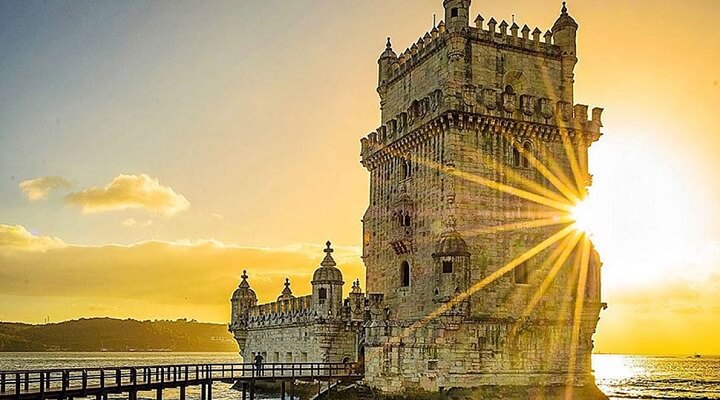
Today is the day to get to know Lisbon and it`s geography, the day schedule will be made according with your interests and curiosities.
Lisbon downtown the most destroyed neighborhood with the 1755 earthquake that devastated practically whole of Lisbon, causing immense changes, in the locals and in the architecture itself, with the Pombaline architecture.
Being the buildings reconstructed in a completely different way, wider areas with more streets and squares, anticipating a new earthquake all by the hands of Marquis de Pombal, the person responsible for the reconstruction of Lisbon and other economic and social changes.
Going up to Alfamawe will visit the Lisbon Cathedral, its Romanesque architecture built in the 12th century, as well as the Saint Antoni´s Church, this Portuguese matchmaker, in Alfama, our days a neighborhood closed to the traffic where only residents can enter by car, if you wish you can take a walk and let yourself be enchanted by its alleys, in this ancient Arabian Medina.
Crossing Avenida da Liberdade until we reach Marques de Pombalsquare where we will stop next to Parque Eduardo VII and try to understand the relationship and treaties between Portugal and England and the importance of this relationship in the future of Brazil while enjoy this fantastic view.
After lunch our day continues to Belem, an open book during the period of of the Portuguese maritime expansion, the place of the old shipyards and ports of Lisbon, from here courageous Portuguese explorers in the 15th century discovered the sea routes for India, Africa and Brazil, celebrating this glorious past, financed by the vast wealth that flowed to Portugal from the colonies.
Here we will then visit these three important Monuments; The Belem Tower, Jeronimos Monastery and the Discovers Monument, the last stop will be in the famous Belem pastry factory, to taste this fabulous conventual pastry that attracts millions every year.
We must visit the Nations Park, where in 1998 Lisbon hosted Expo 98, inspired by the glory of the Portuguese (maritime expansion), with its bold but also functional architecture, to get to know the great work Calatrava, the same one that designed the Museum of Tomorrow in Brazil.
A modern Lisbon, where public transport works has simplified what has greatly improved access to the center of Lisbon, in addition to the offices of many of the national and international companies.
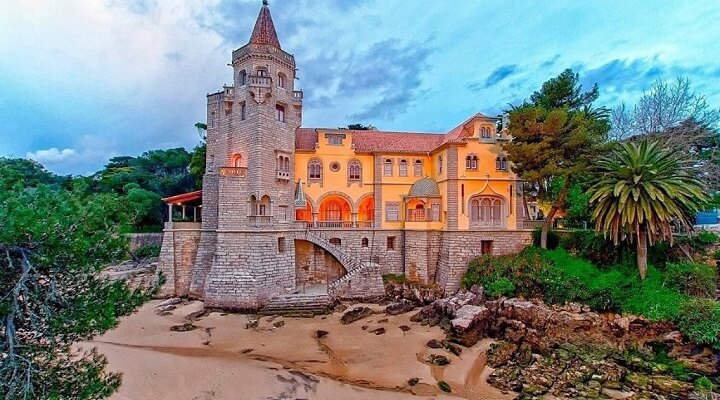
Today will be the day to visit Sintra, we will start at the Queluz Palace(optional visit), the palace where the Royal Portuguese family was living when the French invasion, who “force” them to move the capital to Brazil and where Dom Pedro IV of Portugal was born and died curiously, which at the same time was Dom Pedro I of Brazil.
Its rococo style stands out in its fantastic uneven gardens well disguised by the sequence of terraces and galleries with Tuscan columns, topped by a monumental staircase, a strong decoration in statuary clearly inspired by classical and allegorical mythology, connoting the geometric beauty of the hedges of boxwood and the polychromatic tiles with the stone and bronze of many of its statues.
Time now to enjoy the center of Sintra, where countless Portuguese handicraft shops are available, as well as the famous Travesseiro de Sintra, at Pastelaria Piriquita, free time to enjoy this wonderful place.
Sintra a place with a great concentration of historical monuments and very interesting tourist attractions, here we will find more than 10 national monuments, including opulent palaces, ancient ruins and decorative palatial houses scattered over the different region hills, this on quite challenging walking paths.
Your guide will help you decide which palace to visit (we suggest a maximum of two), between; Pena Palace, Monserrate Palace, the Masonic Quinta da Regaleira (with its original well), if you want something more Medieval, maybe the Moorish Castle, the choice is yours according to your taste or curiosities.
We then continue through the always beautiful Serra de Sintra towards Cascais via Colares, a mandatory stop to visit Cabo da Roca(the westernmost point of the European continent), “where the Earth ends and the sea begins” words by Luís de Camões written in Os Lusíadas, (Canto VIII).
The imposing 165 meter high Lighthouse built in 1772, the Atlantic Ocean “strength”, revealing us as one of the most emblematic places in Portugal, a place of extreme importance during the period of Maritime expansion.
Arriving at the Cascais village with its beautiful bay, today a very pleasant place to live or even a small vacation, full of small fishing boats, free time to explore this small village, so recognized that it attracts thousands every year.
Between the bay of Cascais and the Serra de Sintra, Cascais was during the 19th century, the place chosen by the Portuguese royal family for holidays that ended up dragging all the nobility, in Largo de Camões, in the historic center, you will find many shops and restaurants.
Estoril, nest of espionage during the second world war, where Yan Fleming lived, this renowned writer, that gave rise to 007, where you can dazzle the immense properties as well as the EstorilCasino (considered the largest in Europe).
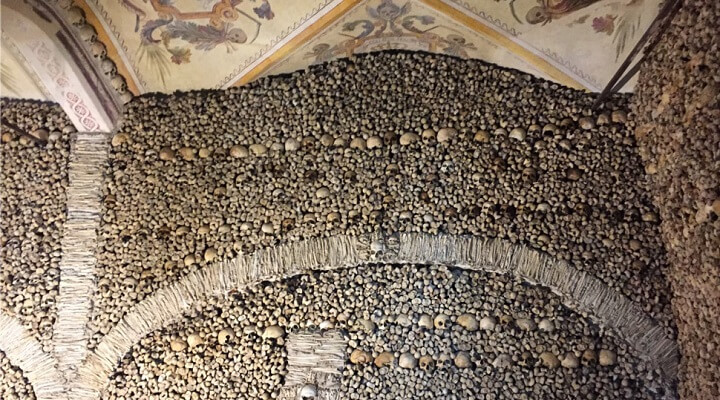
Today we are going to visit Alentejo, starting with a visit to a traditional cork factory , where we will learn whole process, from getting to know the tree (cork oak), its extraction, the choice, preparation to the final product.
Did you know that the bark of the Cork Oak grows every year and that every nine years it has to be removed from the tree, reaching 25 centimeters thick, the perfect material that is resistant to heat, cold and fire, after removing the cork the tree regenerates again.
Portugal is responsible for 55% of the cork world production, today highly valued, whether in decorative wall and floor coverings, or even in the manufacture of sporting goods, the ideal material for baseball grains or cable. fishing rods.
However, in many countries cork is best known for being a raw material for wine corks as it allows micro-portions of oxygen to come into contact with wine, so that wine can “age” while maintaining its quality.
Time now to enjoy Evora, explore this beautiful medieval village that betrays thousands of people every year, the Bones Chapel attracts more attention, this sinister chapel with walls and pillars lined with human bones and skulls it is estimated that there are more than 5,000 monks. Do not be alarmed when reading at the entrance; “We the bones standing here for yours we wait” because it only takes us to reflect on life.
Another monument of great value is the Temple of Diana or Evora Temple, which lives up to the importance that the Romans gave to this beautiful city, next to the Cathedral, built in during the Roman period, from here we can see the magnificent aqueduct of “Agua da Prata”, outside the city walls and extending from the city outskirts some of its arches are still visible inside the city, built in the 16th century to guarantee water transport .
Not only did Romans live here, the Arabs built their streets and alleys in the 11th and 12th centuries, but Evora was also the residence of some Portuguese kings, a point of convergence for renowned artists, supported by Portugal’s reigning patronage and dynasty.
This we can include a visit to a winery in Alentejo, region of good wines, our winery will be Ervideira where in addition to the visit to the Winery and personalized explanation, from grapes reception during the harvest to the bottling line, then the tasting of white, rosé and red wines.
A region that produces unique wines, this in a region of hot and dry climate, being essential to use water drip system in the vineyard, with soils and reliefs a very sunny area that allows a perfect ripening of the grapes.
The Alentejo is practically a flat region, that produces white wines that are generally soft, slightly acid and with aromas of tropical fruits, while the red wines are full-bodied, rich in tannins and with aromas of wild and red fruits.
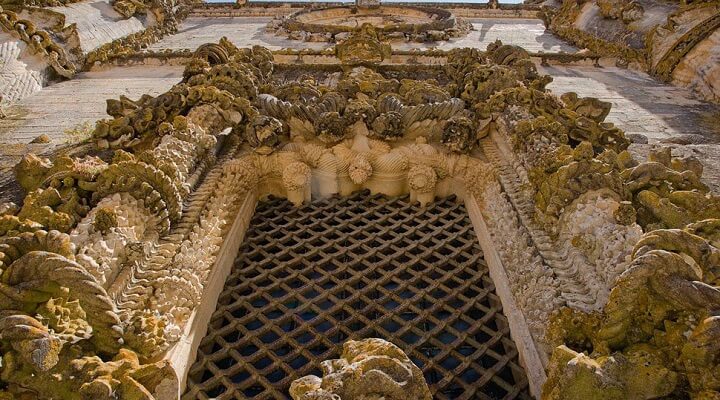
On the fourth day of our Itinerary 9 days in Portugal, we will leave Lisbon, being our first visit to the Templar´s land Tomar.
Being the oldest part of the city (Medieval) oriented at cardinal points in cross, with a convent in each of its extremities, and in the center the main square “Praça da República”, with the Igreja Matriz to the west the castle hill and the Convent of Christ.
Countless traditional shops here you can also find the oldest cafe famous for its almond and chila cheese and the traditional Slices de Tomar, made only with egg yolks and cooked in a water bath in a very special pan, according to the legend invented by a coppersmith in the city in the mid-20th century.
Visit to the Church of Santa Maria dos Olivais Church built in the 12th century, the headquarters of the Templar Order in the country, with 3 naves classified as a National Monument in 1910 and is one of the most emblematic examples of art gothic in Portugal. Here is buried Gualdim Pais, founder of the city, and other grand masters of the Order, a Church that seems smaller than it really is since it is buried two meters below the ground.
The construction of the Templars Castle/ Convent of Christbegins with the Templar castle, at the forefront of medieval military architecture from the same period, the Romanesque Charola, inspired by the Church of the Holy Sepulcher in Jerusalem and which assumed the dual role of oratory and military watchtower. When the Military Order of the Temple was extinguished, the Portuguese King Dinis, created the Military Order of Christ, who came to be heir to the goods, graces and privileges that had belonged to the Templars.
Fatima, considered by many to be one of the most important Marian Shrines in the world, where we will pay homage to Lady Marie, by visiting the two Basilicas there; Nossa Senhora do Rosario and Santíssima Trindade and of course the oldest of them the Apparitions Chapel.
The Chapel of the Apparitions the first Chapel to be built right after the apparitions of Lady Marie, located in the center of the Sanctuary, an unmissable place, not for its grandeur, but for its meaning.
At one end the Basilica of Our Lady of the White Rosary, built in 1928 with neo-baroque architecture, here you will find the tombs of the three shepherds the children (francisco and Jacinta), and now also the tomb of sister Lucia, who died in 2005, at the other end, the imposing Basilica of the Holy Trinity, built in 2007 with more than 8,000 seats and 40,000 m² of area designed by the Greek architect Alexandros Tombazis.
Then we arrived at Coimbrawith many attractions, the University where the Biblioteca Joanina occupies a prominent place, the construction of the it began in 1717, above the old University prison, with the purpose of housing the university library and completed in 1728, its ceiling, the frescoes were executed by the illustrious Mestre António Ribeiro and Vicente Nunes, and the portrait of Dom João V at the back of the room was made by the Italian Domenico Dupra.
IMPORTANT – If visiting Coimbra the interior visit to the University is essential to you, let us know when booking your Itinerary 9 days in Portugal to book the tickets in advance (not included in the price), as the visit to the Joanina Library is numbered and otherwise it will be practically impossible to make the visit at the moment, after the reservation made the customer will be charged the same amount at the end of the tour (12,5 € / person), even when visiting is not carried out due to the client’s withdrawal or delay.
After enjoying the library, we will continue to visit the University of Coimbraother interesting places such as; Saint Michael Chapel, Capelos room, the tower, among others. Despite having been built following the royal project for the reform of university studies (a consequence of the spread of the Enlightenment currents in Portugal), the Joanina Library is recognized as one of the most original and spectacular European Baroque libraries.
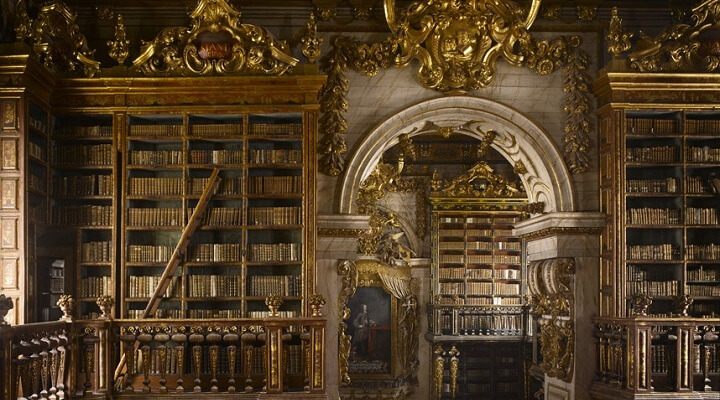
Today we finish our visit to Coimbra, with the visit to Baixa de Coimbraor Coimbra Historic Center, the name given to the central area of the city. The designation was developed with the separation between “Alta”, where the nobility lived, the clergy and, later, students and “Baixa”, predominated by commerce, handicrafts and riverside neighborhoods.
A region to relax and get lost in this charming city, its narrow streets, beautiful alleys and squares, where you will find countless cafes, pastry shops and restaurants.
In Aveiro , the Portuguese Venice with its canals, previously used for the transport of salt, explore its historic center with numerous Art Nouveau buildings all cataloged by the city, as well as its market however by Gustavo Eiffel.
Time to get to know and try their traditional sweets, the “soft eggs”, a possible Moliceiro boat trip, these small boats that almost resemble gondolas. A visit to the salt pans, the salt industry, continues to be important in this center, which for many years was dedicated to salting cod.
Costa Nova haystacks are famous and streaked striped houses on the beach, originally in shades of ocher red and black, later used as warehouses for fishing implements, in the summer and autumn months, transforming them into the current “haystacks”, with colored stripes, in the “bourgeois fashion of going to the baths” of the second half of that century, so that they could serve as housing in the bathing season.
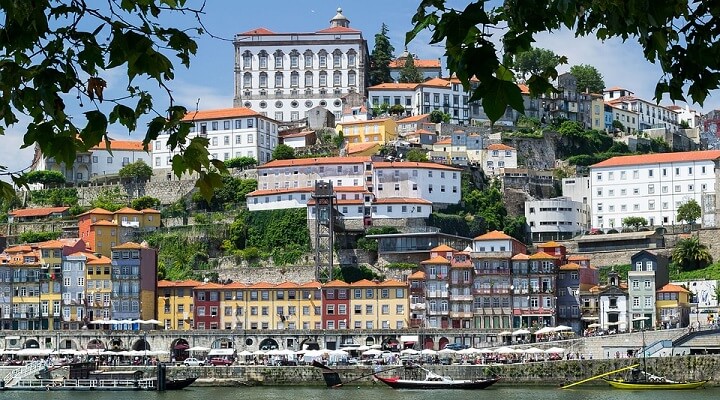
Today we will understand why Oporto is considered one of the most beautiful cities in Europe, starting with Casa da Musica this monumental amphitheater with modern but functional architecture, towards Matosinhos with its port and Foz where the upper-middle class lives.
At the Oporto center, along Avenida dos Aliados with the city hall as the most emblematic building, as well as the statue of Dom Pedro I of Brazil, which demonstrates his love for the city, since when he died, he decided that his heart should say here.
The beautiful Sao Bento train station where Jorge Colaço’s 20,000 tiles will take us on a journey through Portuguese History and the traditions of Douro and Minho, a true open book that awaits us to show us true city experiences.
Oporto busiest street in the city is Santa Catarina Street full of national and international commerce, one of the biggest attractions being Cafe Majestic, a luxurious cafe that tells the story the city of the 1920s, its political intrigues and the debate of ideas, the Oporto of the “Bélle Époque”, of many writers and artists.
Right afterwards our Tour will take us to visit one of the most famous and beautiful bookstores in the world, the Lello Bookstore, reason that led to one of the famous Harry Potter films having been inspired in this extremely charming bookstore with the interior resembling wood, then the Oporto Cathedral with a fantastic view of the city, the Bolsa Palace the San Francisco Church among others.
We will then cross the Ponte de D. Luis, to Gaia where we will visit one of the Port Wine cellar, to understand the entire production process of this unique wine, which is Port wine, very close the Serra do Pilar Monastery with a stunning view of the city as well as the mouth of the Douro River.

Today we are going to get to know Santiago, with a short stop in Vigo to visit and who knows how to have lunch, Pescadería Street may be one of the suggestions, one of Vigo’s most interesting tourist spots, on the street the ostreiras open the mythical oysters of the Vigo estuary and prepare the different dishes.
Traditionally, mollusks are bought directly from the ostrich and tasted natural, with a little lemon and Alvarinho wine. Then we continue to Santiago de Compostela, its serenity, history with its university and students, its medieval streets full of music, art and pilgrims from all over the world who share their experiences.
A visit to the Santiago Cathedral is unique, according to tradition, here is the tomb of the apostle Santiago Maior, patron and holy protector of Spain, for this reason it has become the main Christian pilgrimage destination in Europe to follow Rome during the Middle Ages.
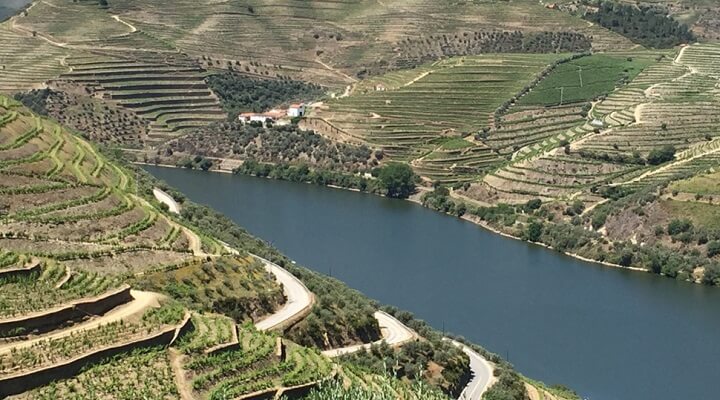
Undoubtedly, the Douro Valley is another beautiful place in Portugal, and not only for those who are “wine lovers”, we start with Amarante, our first stop and where we can pray to a well-known matchmaker Saint Goncalo and admire the church and convent named after the venerable figure we can also see the 18th century bridge that joins the banks of the Tamega River, the largest tributary of the Douro.
We continue towards Vila Real, more specifically to the Mateus Palace to be able to admire one of the most beautiful Baroque palaces in Portugal with its gardens and history. The famous Mateus Rosé wine originated in this Palace or Solar de Mateus.
Our itinerary then goes to the Alto Douro wine region, to admire a breathtaking view at the Casal de Loivos viewpoint and visit the Pinhao Train station where the 24 tile panels show us the hard work in the production of the precious nectar. This region was considered by UNESCO as a World Heritage Site in 2001.
And now the reason that brought us to Alto Douro Wine Region, is to visit a Quinta, where we will understand this whole process, from cultivation, pruning, harvesting, to the long awaited final product, wine and for sure that in the end we will have the same opinion together, as much as it costs to produce it, it is clear that in addition to so much talk, it is time to try it.
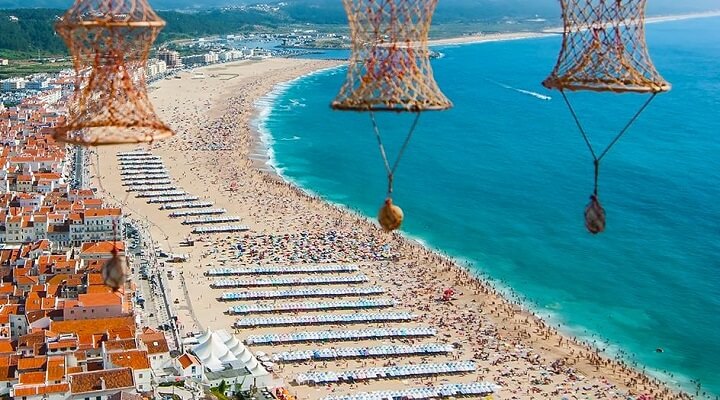
This will be the day to return to Lisbon, but on the way we will visit Nazare (the most charismatic fishing village in Portugal), where we can see the drought of the fish on the beach, as well as the “ladies of the Seven skirts” proudly shown by themselves. Our days Nazare is also known for its giant waves, yes the biggest waves in the world are here in Portugal.
All thanks to the phenomenon of Nazare cannon, phenomenal waves that made Nazare famous all over the world, in 2013 the American surfer McNamara broke the world record by surfing a wave of about 30 meters high, over the period of the year we can see them with our eyes.
In Alcobaca we will visit the Monastery built in the sec. XII and still attributed by the first king of Portugal to the Order of the Cistercians, a place that houses the tombs of Pedro and Ines, the famous but tragic Portuguese love story
Built with an architecture applied to the central nave over a hundred meters long and extremely imposing, where the monks wander in prayer, supported by arches, the kitchen and the solutions applied here to bring water to a wide space and already with hygiene concerns .
Will arrive at Obidos (Unesco world heritage), we will take a trip back in time to the medieval period and exploring the beautiful and narrow whitewashed streets that Obidos has to offer.
Obidos belonged to the defensive pentagon of the five Castles, this by the hands of the Templars, later used as a wedding gift from D. Dinis to his wife D. Isabel, the village became part of the Casa das Rainhas, the majority of the Portuguese queens in Portugal were financed here, leaving great benefits there too. Catarina orders the aqueduct and the fountains to be built.
Airport transfer
Our tour
Reviews Tripadvisor
 Fizemos um tour de 2 semanas por Portugal com o guia Carlos Rodrigues. Tudo correu perfeitamente e não tivemos problema algum. O Sr. Carlos foi muito profissional e cordial. Recomendo!
Fizemos um tour de 2 semanas por Portugal com o guia Carlos Rodrigues. Tudo correu perfeitamente e não tivemos problema algum. O Sr. Carlos foi muito profissional e cordial. Recomendo!

19 de January, 2023
 Fizemos um passeio saindo de Lisboa, para Óbidos e Sintra. Nosso guia e motorista, Sr. Pedro foi especialmente atencioso com todos, fornecendo informações sobre os locais visitados. Com certeza, se... read more tivermos outra oportunidade, faremos outro passeio guiado com a Walkborder. Sr Hugo também foi muito atencioso e prestativo conosco. Recomendo.
Fizemos um passeio saindo de Lisboa, para Óbidos e Sintra. Nosso guia e motorista, Sr. Pedro foi especialmente atencioso com todos, fornecendo informações sobre os locais visitados. Com certeza, se... read more tivermos outra oportunidade, faremos outro passeio guiado com a Walkborder. Sr Hugo também foi muito atencioso e prestativo conosco. Recomendo.

22 de April, 2022
Social Share
Best Sellers
2 Days Tour in Porto
2 Days Tour in Lisbon
Oporto Tour
Douro Valley Tour
Sobre
A Walkborder é uma agencia de viagens de Turismo Receptivo em Portugal , efetuamos topo o tipo de Transfers , Passeios Privados e Roteiros Privados.
Telefone: (+351) 963 666 009
Email: geral@tours.com.pt





